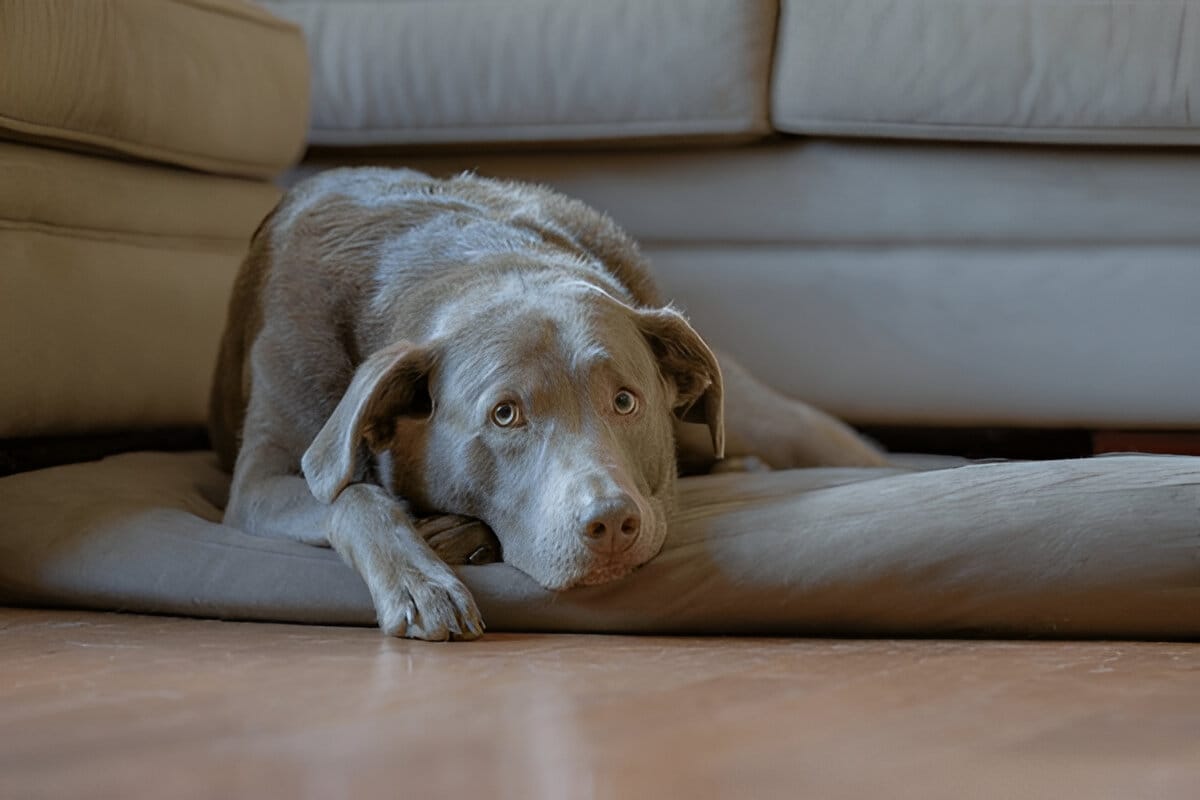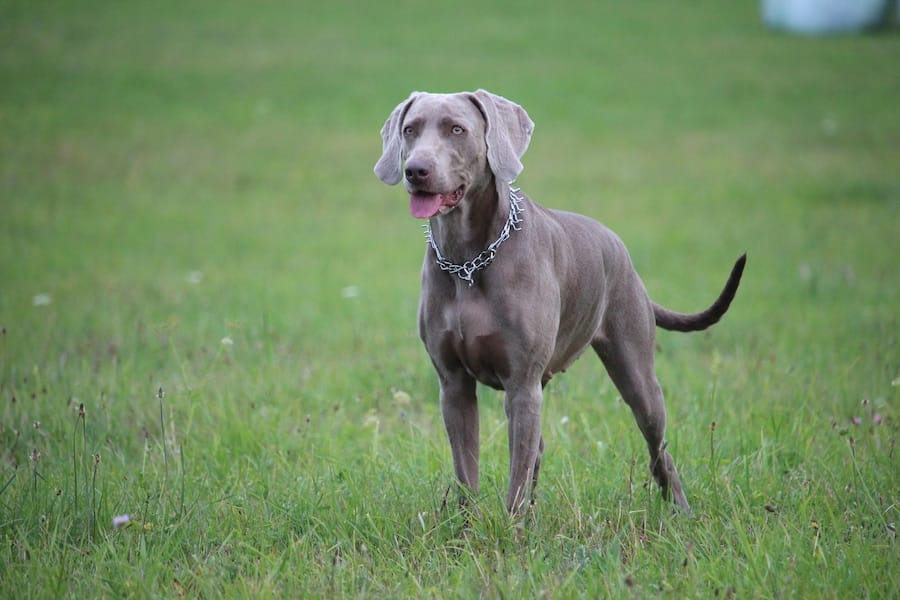Silver Lab Background
When the American Kennel Club (AKC) released its annual list of most popular dog breeds in 2019, Labradors topped the chart for the 28th year in a row.
While most people immediately think of the classic Yellow, Chocolate, and Black variations we know and love, there’s a beautiful Silver Lab puppy that’s been increasing in popularity among dog enthusiasts. Having worked with these traditional and adored canines for over a decade, I’ve witnessed firsthand how their friendly, outgoing personalities make Labs energetic, loyal, sociable, and lovable companions.
The difference with Silver Labs lies in their unique grayish-blue color, that’s quite famous for topping the list of great dogs due to their social personality.
But wait – this rare coat variation doesn’t actually exist as a different breed entirely, though some argue it’s a mix between a Labrador and Weimaraner, another incredibly obedient breed, which can make things more confusing.
The AKC considers Silver Labs a type of Chocolate Labrador Retriever, and if you’re considering this pup as the perfect family companion, you might still be a little puzzled about their origins.
After my extensive review of this distinct coat phenomenon, I can tell you that when colors come to mind about Labs, you didn’t immediately think right about this variation because of the presence of a dilute gene that has caught the attention of many dog lovers.
However, this striking appearance comes without some controversy, as Silver Labs aren’t considered purebred labradors widely across all breeding communities.

Photo credit: Shutterstock by UA-Visions
About the Breed
Silver Labrador Retrievers are one of the rarest shades of labradors, and despite being a hyperactive breed with a compelling sporting nature, they respond well to training and enjoy exploring if you love playing water sports or are fond of a good fetch game, making them perfect for active families.
These beautiful dogs are well-known for befriending every creature they see without any degree of hesitation, and their natural tendency of being the center of attention means they thrive on social interaction – though they can be a little clingy at times, but they deserve all that love for their service of just existing with such an agreeable personality.
Their intelligence makes them one of the most charming breeds you can find, and from my years of working with various Labs, I’ve seen how their communication skills surpass many other canine companions.
Besides the unique coat color, Silver Labradors aren’t much different from other labs. However, according to the standard set by the American Kennel Club, true purebred Labradors are only yellow, black, and chocolate in nature.
This Silver variation is not considered a purebred labrador and isn’t accepted by most kennel clubs worldwide. Many breeders believe the Silver colors are due to cross-breeding with Weimaraner’s, though these dogs aren’t formally recognized by the American Kennel Club either.
According to the AKC, these Silver Labs are basically Chocolate Labs with a pair of dilute genes, thus they’re classified as Chocolate Labs. Pure Yellow, Black, and Chocolate Labs from reputable breeders typically cost around $500 to $1000, while a Silver Lab puppy sells for $800 to $1500 due to their rarity.
History of the Silver Labrador
The history of Labrador Retrievers traces back to the 1800s when they were created in Newfoundland and first introduced to European Britain by settlers via ships trading between Canada and Poole.
Labs were initially bred for duck retrieving and assisting in fishing adventures as the perfect hunting dog, and over time their popularity grew as more families welcomed them as household pets, especially in the western world.
The Silver Lab, however, isn’t as old as other retrievers and their origins aren’t well chronicled either – they started appearing according to some sources around 1917, while others believe it was in the 1950s. Since they weren’t considered purebred Labradors by the Kennel Club, many breeders thought they were a mixed breed between a Chocolate lab and Weizemarnier.
History shows us that traditional Labs have their dates firmly established in England, where Hunters loved them for their innate ability to retrieve ducks, and after a whole century of careful developing and meticulously recording the characteristics of each litter, they were formally registered with the AKC.
Most kennels strived to maintain Black litters, though historical records include documentation of tan, red, and brindles in addition to the traditional Yellow and Chocolate varieties.
No one seems to know quite where Silver Labs come from, and having studied breeding records extensively throughout my career, I can tell you this mystery adds to their intrigue.
Before an advertisement for “Rare Gray” Labs appeared in a hunter’s magazine in 1950, there was virtually no record of these modern Silver Labs. They emerged seemingly from nowhere, only adding to their allure and mystique.
We now understand that their clear and distinct coat colors are due to the presence of a recessive dilute gene pair that has recently appeared in the gene pool, but the exact source of this gene makes their exact origin remain vague, which is why their profile remains controversial for the most part among purebred enthusiasts.
Silver Labrador Facts
Silver Labradors have striking blue eyes as puppies that gradually change color as they mature, and from my experience working with these unique Labs, they are more prone to developing skin problems such as Color Dilution Alopecia than other Labrador varieties, which is directly linked to their dilute gene.
Despite these potential health considerations, Silver Labs remain incredibly outgoing and social companions who are intelligent and highly trainable, making them wonderful family pets when you understand their specific needs and provide proper care for their distinctive coat requirements.
Silver Labrador Appearance
Just look at any Silver Labrador slaying in this picture – like he was born to model for the camera! Silver Labs undoubtedly possess the most distinct silverish gray color that leaves an unforgettable impact on every observer. Their eyes are a beautiful shade of yellow which, combined with a relatively small black pupil, looks absolutely striking.
They have long floppy ears that rest flat against the sides of their head, and their nose is always in search of something to eat or sniffing butts and tends to be brown in color.
These rare labradors have an indescribable charm that keeps winning people over, and Owners tend to be drawn to their wide skulls and muscular build – they’re incredibly strong, so try getting hit by their tail and you will know how powerful they are as it wags non-stop upon your sight, indicating you’re welcomed and loved.
Now, let’s talk about some concrete physical attributes of these magnificent dogs. In terms of size, the Silver Retriever is a large-sized breed, and The average height range for almost all grown Silver Labs falls between 23.5 to 24.5 inches.
Regarding Weight, a male Lab is slightly bulkier in contrast to a female counterpart – On weight, a fully-grown male falls between 55 to 80 pounds, while females range from 45 to 70 pounds in most case scenarios.
Their Coat characteristics are equally impressive – a Silver Lab has a double coat to protect them against harsh cold weather conditions, with the inner layer being denser and thicker as compared to the outer layer which is thin and short.
Moreover, the Lab’s coat is water-resistant, meaning they can enjoy water sports time without any health concerns, and overall it feels smooth and shiny – it feels absolutely euphoric to pet. When discussing Color variations, unlike other variations of Retrievers found in Black, Chocolate, and Yellow – the most common shades – silver represents a diluted chocolate variation and is the least common of all Labrador colors.
Silver Lab Puppies
A Silver Labrador puppy is one of the most aesthetically pleasing sights to behold with your eyes in the entire world, featuring that captivating sparkly blue gaze and smoky grey shade that make a truly striking contrast against their soft fur.
However, their mesmerizing blue eyes don’t stay that way permanently – As time progresses, they tend to darken significantly, and from my years of experience raising these beautiful pups, I’ve observed how Their eye color will turn yellow after the pups cross the age of 6 to 8 months, transforming from those enchanting baby blues to the classic amber hue we see in adult Silver Labs.

Photo credit: Shutterstock by Cranksetter
Silver Labrador Temperament and Personality
Talking about Silver Lab temperament, just like other Labrador Retrievers, they too have incredibly friendly, affectionate, and caring personalities that make them irresistible companions.
They are a very intelligent breed that makes the best companion to their human family, and This high-spirited dog matures physically but remains child-like at heart, constantly lifting the mood around the house by being jolly, goofy, jumpy, and adored by absolutely everyone.
The Silver retriever has an easy-going personality which means they enjoy every activity with you and want to feel your touch no matter what you do throughout the day. It is because of this deep attachment to owners why they’re prone to exhibiting signs of separation anxiety when left alone on their own for long periods, and Moreover, it demonstrates their social nature as they thrive on attention from people around them.
These sweet creatures are natural friends with kids, as Silver Labs are incredibly patient and gentle toward children and can be their playmates for hours without getting tired or irritated.
One of the remarkable qualities of these dogs is how they get along really well with other pets – labs aren’t aggressive toward strangers at all, and On the contrary, they become excited at the sight of another dog and want to hang out with them, often trying to impress others with how cool they actually are! Plus, there isn’t much barking from them either, except when there is a little reason to be anxious, though they also tend to chew upon various objects due to their naturally active nature – similar to black and yellow Labs in this regard.
In order to keep them away from destructive behaviors, Silver Labs need to stay mentally stimulated and avoid nipping habits, so they require a lot of exercise and engagement.
If you love outdoor adventures like hiking, then these remarkable dogs will prove to be an extraordinary companion who matches your energy and enthusiasm for exploration, making every adventure more memorable through their infectious joy and unwavering loyalty.
Silver Labrador Health and Care
Labrador Retrievers’ care needs can be a little overwhelming for lazy owners who expect minimal effort, But in reality, they aren’t that much of a high-maintenance breed compared to many other dogs. Due to being double-coated, Silver Labs shed a fair amount of hair throughout the year, especially the Silver variety because of their unique genetics and potential skin problems that require regular brushing and monitoring – from my experience working with these beautiful dogs, consistent grooming and health check-ups are essential to keep them comfortable and looking their best.
Grooming Requirements
Brushing
As we mentioned above, Silver labs shed quite a bit throughout the year, And by this I mean you will be able to collect an adequate amount of hair from all over the house, especially during peak shedding season when their coat naturally renews itself.
That’s why most experienced owners brush their labradors daily to significantly reduce shedding and maintain their beautiful coat – from my years of grooming these dogs, I’ve found that consistency is key.
Using coconut oil at least once a month can keep their coat neat, shiny, and soft to the touch; simply gently massage the oil into their fur for about five minutes, then clean it off with a clean towel to remove any excess residue.
Bathing
Bathing your Silver Labrador Retriever once a month is adequate for maintaining their beautiful coat and skin health, though you should always brush them before and after the bath, then dry them properly when you’re done to prevent any skin issues.
Use lukewarm water and mild shampoo specifically designed for dogs, as it will keep their skin well-maintained and prevent irritation that Silver Labs can be prone to due to their dilute gene.
Most Silver Retrievers don’t give you a particularly hard time with bathing, so you can wash them on your own pretty easily – from my experience, they tend to be more cooperative than many other breeds, especially if you start the bathing routine when they’re young.
Nail Trimming
Trim your Silver labs’ nails every two months as a regular routine, However, if you start noticing the scratching sound of their nails against the floor while running, walking, or jumping around, trim their nails immediately to prevent discomfort and potential injury.
Ear Cleaning
Their adorable floppy ears need to be checked and cleaned frequently to prevent any potential infection, so Always include ear cleaning in their regular grooming session for optimal health and comfort.
Health Complications in Silver Labrador
Every breed is likely to face minor or major health complications, and we have listed all the possible conditions your Silver Labrador Breed could suffer from – When getting a Silver Lab, always look for a reputable breeder who conducts proper health screenings.
Life Expectancy
Silver Labrador dogs typically have a lifespan between 10 to 14 years, though It can vary from dog to dog based on health issues, environment, and other factors like diet, exercise, and genetics.
Color Dilution Alopecia ( CDA)
CDA, or Color Dilution Alopecia, is a genetically inherited condition that’s particularly common in color-diluted variations of dogs like the Silver Lab itself. Having worked with numerous Silver Labs over the years, I’ve observed how it occurs due to the presence of a recessive gene that affects the coat structure.
In this condition, your dog suffers from various skin problems including hair loss, or thinning that appears in the form of distinct patches across their body. The affected areas often show itchiness, scanlines, and flaky skin texture that can be concerning for pet owners.
The mechanism behind this condition involves hair breakage that happens through self-destruction of follicles, which tend to not grow back in most cases. From my experience treating Silver Labs, this makes the dog’s coat look quite unflattering, but fortunately doesn’t impact their overall health much except for slight discomfort during flare-ups.
There’s no proper cure for CDA, but vets give targeted treatments to tackle secondary infections that may develop. They also advise using mild grooming products and specialized shampoos that are gentle on the affected skin and aid in decreasing follicular plugging.
One crucial recommendation I always share with Silver Lab owners is to avoid brushes with harsh bristles that could further irritate the compromised skin areas.
Hereditary Myopathy
As the name explains, hereditary Myopathy, also referred to as centronuclear myopathy, is a genetic disorder that causes severe muscular frailty in Silver Labradors. The deficiency of type II muscle fibers leads to devastating weakness, resulting in heartbreaking symptoms like stunted growth, trouble swallowing, stiff arched back, shrunken muscles, and extremely low tolerance for exercise.
From my years of veterinary experience, I’ve witnessed how these devastating signs start appearing when a puppy reaches six to eight weeks old, but they aren’t chronic initially – they progressively get worse and are most prominent by 5 months of age. Sadly, puppies with CNM are often subjected to euthanization due to their complete inability to function normally in life, and no dog owner should ever have to go through this painful experience.
Hip and Elbow Dysplasia
In Silver Labradors, the elbow and hip dysplasia occurs when ball and socket joints don’t rotate, flex, extend, or move as they should normally, significantly affecting mobility in these active dogs. This developmental issue in both joint areas causes considerable difficulty or friction when climbing stairs, jumping, running, or even simple walking activities that Silver Labs typically love.
From my clinical experience treating numerous cases, it is a painful condition that drastically affects the quality of your dog’s life and requires you to put extra care into managing your Silver Lab’s daily activities as a responsible dog owner.
Exercise Induced Collapse
Labradors, and Silver Labs specifically, have their unending love for playing and physical exercise that is not something hidden from any owner – their energy drive runs incredibly high. EIC refers to the recessive autosomal inherited trait that affects these active breeds in devastating ways.
Your Silver Labrador Retriever, despite feeling weak during episodes, will still try to be active because of their natural temperament. It will show alarming signs like dragging or forcing their back legs to move, appearing shaky, excessive panting, or drooling accompanied by a body temperature higher than usual.
Then, after five to ten minutes of intense activity, they suddenly collapse completely. Extreme exercise sessions are strictly avoided in dogs with this condition for obvious safety reasons.
However, it’s important to keep your Silver Lab active, just don’t go overboard with the exercise requirement as it can lead to dangerous weakness episodes that I’ve witnessed firsthand in my veterinary practice.
Ear Infections
Silver Labradors are the derivatives of Chocolate Labs and are significantly more susceptible to ear infections than yellow Lab and black ones, with about 23 % of them being prone to having these issues. Bacteria buildup, yeast growth, foreign parasites & objects, plus allergies can all lead to infections in these dogs, which from my clinical experience treating Silver Labs becomes quite problematic.
This results in excessive discharge from the ears, visible inflammation, constant itching, foul odor, and persistent head shaking that owners quickly notice. Otitis Externa is one of the most common types I encounter, characterized by ear canal inflammation that creates unpleasant and painful sensations that cause significant discomfort for your Silver Lab.
Consult a local veterinarian right away if you notice any of the above symptoms developing in your pet.
Over Eating
Labrador Retrievers are quite popular for being notorious foodies, and Silver Labs inherit this trait completely. Some scientists associate it with a genetic mutation that affects their satiety signals, which I’ve observed consistently in my practice. Now, overeating alone isn’t that big of an issue initially, but the secondary health problems it causes become serious concerns – obesity, diabetes, and reoccurring stomach issues are common complications I treat regularly.
Sometimes excessive eating might also indicate underlying serious conditions like hypothyroidism that requires immediate medical attention in Silver Labs.

Photo credit: Freepik by EyeEm
Silver Labrador Diet and Nutrition
Your high-energy Labrador Retriever needs a high-quality, nutritious, and protein-rich diet to function healthily throughout their active lifestyle. The amount of dog food you feed them may vary a little with their size and weight – for example, your Silver Lab weighing 50 pounds will need about 2 and a half cups of good quality food daily.
The calorie requirement for an 80-pound Silver Lab is higher as they need 3 cups to fulfill 1,629 calories each day based on my nutritional calculations for these active dogs.
Consider getting food that has adequate calcium for better joint development in your Silver Lab, especially given their predisposition to joint issues. And remember, it is always best to divide the meals into 4 intervals for optimal digestion and to prevent overeating.
These greedy creatures tend to unleash their inner ever-hungry beast at the sight of food, which often causes dangerous bloating that I’ve treated numerous times in my veterinary practice.
Silver Labrador Exercise Requirements
The Silver Lab belongs to an incredibly active family of dogs that require consistent physical engagement. In order to keep them physically and mentally stimulated, 60 minutes of exercise every day is essential for their wellbeing, and if your Silver Lab is super energetic, make it 1.5 hours to properly tire them out. Labs love playing fetch, running, going on fast-paced walking adventures, and being completely goofy during playtime.
Thus, their exercise session can include any of these activity options, just make sure they get enough movement each day. Dedicate one hour of quality time daily to your dog and give them all your attention during these sessions for maximum bonding.
Apart from exercising, you can keep them busy by getting interactive and mentally stimulating toys that challenge their intelligence. Those also help in providing emotional comfort when you leave them alone for a while during work hours.
Silver Labrador Training
Silver Labrador’s trainability makes them one of the most popular dog breeds in terms of family pets globally. They are a highly intelligent breed and can be easily trained since they tend to please their owners – that’s why even a simple good boy phrase works wonders with these dogs, making them a welcome addition to families.
Positive reinforcements work exceptionally well with Silver Labs, and their love for food makes it much easier to lure them into doing literally anything you want. All you need is their favorite treat, toy, or any complimentary reward – boom, your Silver Lab becomes the most obedient dog in the world.
In navigating through the exciting journey of training, embracing technology can enhance both the experience and efficacy of the process. Delve into innovative approaches by exploring Halo collar reviews and Spot On Fence options, revealing the potent capabilities of these advanced gadgets in reinforcing commands and ensuring safety during restricted mobility sessions for energetic Silver Labs.
Like kids, it’s more effective to start teaching proper manners and tricks from a young age. As puppies, they are easier to control and manage, while adult Labs with their larger size can be a little stubborn at times.
Overall, it’s really easy to train a Labrador Retriever – Labradors are the national favorites because they respond exceptionally well to positive reinforcement and reward-based methods, especially when rewarded with treats.
However, they get bored quickly, so training sessions should be kept short but frequent as mentioned above. Being food-motivated, they learn basic commands like sit, down, shake, stay, etc with help of small treat rewards. Just remember to account for the extra calories when using food rewards during training sessions.
Conclusion
Altogether, Silver Labrador dogs have all the lovable characteristics just like the traditional Labs that make them exceptional companions. They are outgoing, energetic, sweet, intelligent, and loyal furry friends who bring endless joy to their owners. Their friendliness towards kids, strangers, and other pets makes them great choices for families with diverse household dynamics. You might face a little difficulty finding reputable silver labrador breeders when getting one, which is something I’ve witnessed in my practice. Not to mention the frowns you’ll get from self-proclaimed lab enthusiasts about Silver Labs ruining the classic Retriever breed standards. But don’t let these things sway your passion for these beautiful dogs – follow your heart and go for it if you’ve fallen in love with the Silver Lab’s unique charm.















